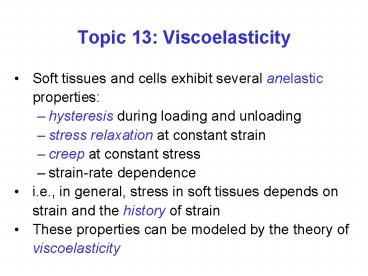Topic 13: Viscoelasticity - PowerPoint PPT Presentation
1 / 23
Title:
Topic 13: Viscoelasticity
Description:
Integrating Eq. 1 for constant applied strain, e0. t=0. Voigt Solid Model ... Exercise: check that the original ODE (Eq. 1) is satisfied by this solution. t=0. e ... – PowerPoint PPT presentation
Number of Views:969
Avg rating:3.0/5.0
Title: Topic 13: Viscoelasticity
1
Topic 13 Viscoelasticity
- Soft tissues and cells exhibit several anelastic
properties - hysteresis during loading and unloading
- stress relaxation at constant strain
- creep at constant stress
- strain-rate dependence
- i.e., in general, stress in soft tissues depends
on strain and the history of strain - These properties can be modeled by the theory of
viscoelasticity
2
Simple Linear Viscoelastic Models
Stress depends on strain and strain-rate Tij
Tij(ekl,Dkl)
- Elastic stress depends on strain (spring)
- Viscous stress depends on strain-rate (dashpot)
- Strains add in series, stresses are equal
- Stresses add in parallel, strains are equal
3
Maxwell Fluid Model
Total strain rate spring strain rate dashpot
strain rate
A linear first-order ODE
4
Maxwell Model Relaxation Solution
Integrating Eq. 1 for constant applied strain, e0
?
A monoexponential decay Exercise check that the
original ODE (Eq. 1) is satisfied by this solution
5
Voigt Solid Model
Total stress spring stress dashpot stress
A linear first-order ordinary differential
equation (ODE) Integrating, for constant applied
stress, T0 ?
6
Voigt Model Creep Solution
Initial condition, ?(0) 0
Exercise check that the original ODE (Eq. 1) is
satisfied by this solution
7
Asymptotic and Instantaneous Elastic Moduli
8
Three-Parameter Models
There are various possible configurations The
Kelvin Standard Linear Solid Model
And the equivalent 3-parameter model constructed
from a Voigt model and an elastic element in
series
9
Three-Parameter Models
10
Creep Solution
11
Relaxation
12
3-Parameter Model
13
Stress Relaxation
14
Harmonic Strain Input
15
Linear Viscoelastic ModelsCreep Functions
Voigt Solid
Kelvin Solid
Maxwell Fluid
T
16
Linear Viscoelastic ModelsRelaxation Functions
17
Generalized Voigt Model
Total strain S(strains in each Voigt model)
18
Generalized Maxwell Model
Total stress S(stress in each Maxwell model)
19
Quasilinear Viscoelasticity
- Soft tissues exhibit several viscoelastic
properties - hysteresis
- stress relaxation
- creep
- strain-rate dependence
- Linear viscoelastic models also display many of
these properties - However, soft tissue elasticity is nonlinear
- Quasilinear viscoelasticity combines the
time-history dependence of linear viscoelasticity
with nonlinear elasticity (static nonlinearity)
20
Linear Viscoelasticity General Property
- In all linear viscoelastic models
- the relaxation function k(t) is proportional to
e0 and therefore to T0 - the creep function c(t) is proportional to T0 and
therefore to e0
21
Quasilinear Viscoelasticity
K(t,?) T(e)(?).G(t) and c(t,T)
?(e)(T).J(t) i.e. in quasilinear viscoelasticity,
the instantaneous stress may be a nonlinear
function of strain but the strain-dependence and
time-dependence are separable. The reduced
relaxation and creep functions are independent of
strain.
22
Reduced Relaxation Function in Tissue
Fig 7.54 page 272 from text book showing mean
normalized relaxation curve for 16 loads from
2-16 g (solid line)
23
Reduced Creep Function
- Figure 8.35 in textbook. A typical creep curve,
plotted as a reduced creep function J(t). Dog
carotid artery.
24
Linear Viscoelasticity Summary of Key Points
- In viscoelastic materials stress depends on
strain and strain-rate - They exhibit creep, relaxation and hysteresis
- Viscoelastic models can be derived by combining
springs with syringes - 3-parameter linear models (e.g. Kelvin Solid)
have exponentially decaying creep and relaxation
functions time constants are the ratio of
elasticity to damping - The instantaneous elastic modulus is the
stressstrain ratio at t0 - The asymptotic elastic modulus is the
stressstrain ratio as t??
25
Quasilinear Viscoelasticity Summary of Key Points
- The stress-strain relation is not unique, it
depends on the load history. - The elastic modulus depends on the load history,
e.g. the instantaneous elastic modulus E0 at t0
is not, in general, equal to the asymptotic
elastic modulus E0 at t0. - The instantaneous elastic response T(e)(t)
E0e(t). - Creep, relaxation and recovery are all properties
of linear viscoelastic models. - Creep solution can be normalized by the initial
strain to give the reduced creep function J(t).
J(0)1. - Relaxation solution can be normalized by the
initial stress to give the reduced relaxation
function G(t). G(0)1.































